An Elephant Never Begets
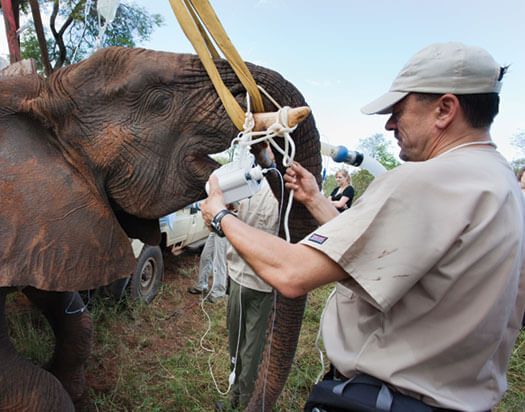
Jeff Zuba prepares a bull elephant for surgery in the bush country on a game reserve near Limpopo, South Africa. An elephant, Zuba notes, is “the largest and potentially most aggressive animal on earth,” and so the veterinary team uses a narcotic called etorphine —many times more powerful than morphine — to keep the patient sedated.
Delivering birth control to elephants is more difficult than you’d think — and more important.
Jeff Zuba ’81, DVM’87 is the Margaret Sanger of the elephant kingdom.
You remember Sanger — the founder of Planned Parenthood, coiner of the term birth control, advocate for people to live rich, healthy sex lives without the consequence of babies. That’s Zuba, only for elephants.
Not many people would aspire to this role. But then, not many people have as much experience with these animals as Zuba does. With the possible exception of his colleagues Mark Stetter and Dean Hendrickson, Zuba has probably seen more elephants — their insides, at least — than anyone else in America.
Zuba is a veterinarian at the San Diego Zoo Safari Park, a facility with more than 2,600 animals representing 300 species. “Most of my practice is small animals, birds, and reptiles,” he says, “but what we’re really known for is the megavertebrates, the big guys — rhinos, hippos, giraffes, and elephants.”
Through his work at the zoo, Zuba first became familiar with elephant anatomy, but that’s not what made him one of the world’s leading authorities on pachydermal contraception. That came through his avocation: along with Stetter and Hendrickson, he founded an organization called the Elephant Population Management Project (EPMP). Each year since 2004, the group has traveled to southern Africa to perform vasectomies on wild African elephants.
It’s not concern with elephant sex that drives him. Rather, it’s concern with elephant health — both saving individual animals now and preserving their environment for the future, as well as a drive to develop elephantine surgical tools and techniques so that veterinarians can better aid the species.
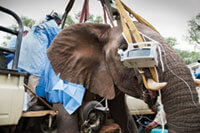
For an elephant, a vasectomy is internal surgery, and so the veterinary team has to hoist him into a modified standing position. The team had to design or modify many of its instruments to be big enough, rugged enough, and battery operated. “Most of the stuff you see in a hospital just plugs into the wall,” says Mark Stetter. But EPMP has to operate “in the middle of nowhere.”
Numbers
When most people think of elephant populations, they tend to think there are too few, not too many. And in the global scheme of things, they’d be right. There are three species of elephant: the Indian (or Asian) elephant; the African forest elephant; and the African bush elephant, Loxodonta africana, which is the largest land animal in the world and the star of this particular story.
The World Wildlife Fund lists Indian elephants as “endangered” and the two African species as “vulnerable,” which is a step better, but still pretty bad. Hunted for the ivory in its tusks and with its habitat shrinking, our friend L. africana has seen its population tumble by as much as 90 percent in less than a century, from around 5 million animals in the 1930s to about half a million today.
However, that decline hasn’t been universal. While elephant numbers in eastern, western, and central Africa have plummeted, those in southern Africa are climbing. More than half of the wild African elephants live in just a few nations — including South Africa, Botswana, and Swaziland — where strict protection defends them from threats and park design fosters population growth.
However, elephants have few natural predators, so herds quickly expand to fill — and overfill — the space available to them. According to Hendrickson, some parks in southern Africa now have twice as many elephants as they can support. Kruger National Park, one of South Africa’s largest game reserves, has a capacity of between 7,000 and 8,000 elephants and an estimated population of 16,000; the nation of Botswana has perhaps 60,000 more of the beasts than it can support.
In such numbers, the pachyderms quickly become a menace to the land they live on. During a recent trip to Africa, Zuba says he saw a small herd of elephants clear all the trees from an acre in two hours.
“These trees are four to six inches in diameter,” he says. “[The elephants] head-butt them and knock them over, and they chew just the top buds. That’s a brat with extra ketchup and sauerkraut to them. They’d chew the buds for about four minutes, and then they move on to the next [tree].”
As numbers climb, the animals turn forests into grassland, destroying the habitat used by many other animals — birds, monkeys, and insects, as well as the animals that prey on them.
“If you go to a place like Kruger, which is a gorgeous place, you’ll see a thousand acres in which all the trees are knocked down,” Hendrickson says. “Maybe that’s not a major problem for the elephants, but it sure is a problem for the other species.”
The parks and game reserves of southern Africa have tried a variety of methods for easing elephant overpopulation. Some have tried transmigrating elephants — that is, shipping them to other parks. But that’s grown difficult as more of the region’s parks have reached capacity. Many have tried culling — that is, killing — elephants. Until the mid-1990s, some parks would cull between 3 and 5 percent of their population each year, cutting out whole herds. But such slaughter caused political problems, and most parks have had a moratorium on culls over the last decade and a half. Since then, elephant numbers have doubled.
Enter birth control, perhaps the most common veterinary surgical procedure — think of all the cats and dogs that are spayed and neutered. “Why not?” asks Zuba. “Contraception is used on pretty much every other species on earth. Why not elephants?”
Several parks have begun experimenting with a drug called porcine zona pellucida (PZP), a contraceptive that can be injected into female mammals — including elephants — in the wild to prevent pregnancies. However, PZP requires multiple injections over the course of months, and the effect of the drug on a wild animal’s health and behavior is unknown.
Stetter and Zuba suggested that a surgical option would be effective immediately and permanently. “Vasectomy doesn’t change hormones at all,” Stetter says. “All the natural behaviors you would expect an animal to have, as far as social status and dominance — how they interact — should be the same. And that’s the ideal way to go. We want everything to be the same, only with fewer babies.”
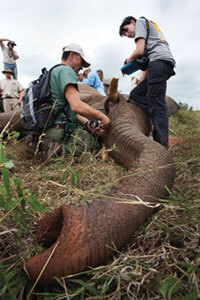
Zuba checks the elephant’s endotracheal tube, a six-foot-long pipe that keeps air flowing into the lungs. The tube connects to a ventilator Zuba invented.
Punk
Zuba is well aware that his organization’s plans run against conventional wisdom.
“It’s outside the box,” he says. “It had never been done before. You’ve got to be really dedicated to the cause to go through what we went through. People were like, ‘That’s typical of Zuba to be doing something like that, but what about Stetter and Hendrickson? They’re smart guys.’ ”
But then Zuba has always been happy living outside the box. With his grizzled goatee and Sconnie accent, he’s a self-professed “snotty-nosed punk from Milwaukee,” who would sound more at home at the far end of a Packer bar, fabricating memories of the Ice Bowl or inventing feats of athletic glory, than working in a lab or operating room. And in fact, Zuba arrived on the Madison campus with his goals set only on sports.
“I had ambitions of wrestling at the UW,” he says, “but the athletic stuff didn’t work out.”
Neither, initially, did the academic stuff. Zuba calls freshman year “the best four years of my life,” and he spent much of that time partying. But his friends from the wrestling team guided him toward a calling.
“A lot of the good wrestlers in Wisconsin come from rural areas,” he says. “I started taking classes with them, and that’s how I ended up in the ag area and getting around animals, and I really enjoyed that. I saw people who were having fun and learning a lot at the same time, and it had never occurred to me that you could do that.”
Under the influence of Professors Arlie Todd, Tom Yuill MS’62, PhD’64, and Barney Easterday MS’58, PhD’61, Zuba discovered animal science and wildlife ecology, two disciplines that led him into zoo medicine. He liked the challenges that he found while studying wildlife — the wide variety of creatures, the complexities of conservation and maintaining a diverse habitat. But more importantly, he liked examining animals, diagnosing diseases and injuries, and making his patients well again.
“If you’re a wildlife veterinarian, you don’t do a lot of clinical stuff,” he says. “You think about herds and flocks and pods, not individuals. It’s more research and epidemiology, and there’s nothing wrong with that. It’s just different. You wait [to see] the rewards of what you do in a year or two or five or ten. In clinics, you’re fixing things right away.”
Zuba’s combination of clinical work and wildlife interest landed him a residency at the San Diego Zoo, and, with the exception of a two-year stint teaching at Colorado State University in the 1990s, he’s been there ever since. Within the small community of zoo veterinarians, he’s made connections with others whose skills and experiences are unusual, including the veterinarians who would become his partners at EPMP, Hendrickson and Stetter.
An equine surgeon, Hendrickson was on the UW’s clinical faculty in the 1990s, but he first crossed paths with Zuba over the innards of a white rhino. A wild animal preserve in Glennrose, Texas, had a rhinoceros with a suspicious tumor, and it called in Zuba and Hendrickson to investigate. Hendrickson is an expert in laparoscopy, a minimally invasive surgical technique that uses a remote-controlled camera and instruments. Zuba calls Hendrickson the world expert in large-animal laparoscopy — and the technique is an important one when it comes to operating on megavertebrates.
“You have to make a big incision, and even in a zoo setting, that’s a challenge,” Hendrickson says. “You have to be very cautious that you don’t end up with a major problem afterwards. If, however, you can do this with minimal exposure, you can limit morbidity and mortality.”
Zuba has known Stetter since the two were veterinary residents, when they met at conferences. While Zuba was learning his trade at the San Diego Zoo, Stetter was at the Bronx Zoo in New York, a facility with more than 600 species, making it one of the largest zoos on the East Coast. Stetter subsequently worked for Disney’s Animal Kingdom, though this past summer he left Disney to become the dean of Colorado State University’s veterinary school, where Hendrickson serves as director of the veterinary teaching hospital.
“[Zuba and I] have been friends for a great many years,” Stetter says, “and we’d actually both been thinking about how we could use laparoscopy to help some of our zoo animals. [Zuba] had been working on it on the West Coast, and I was working on it on the East Coast.”
Disney’s Animal Kingdom is devoted to animal conservation, and so Stetter’s job put him in touch with wildlife researchers around the globe, learning about the challenges that they face.
“Part of my interest has always been how we can take new technologies and apply them to help people in the field,” he says. “I had been working with folks in Africa for many years and basically hearing from them that the biggest wildlife conservation issue they had to deal with was elephant overpopulation.”
The three brought together the interest and experience to try something that had never been done before: could they take the surgical techniques veterinarians use every day and translate them to the most massive of animals in a remote environment?
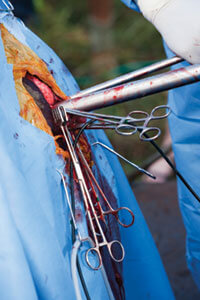
The laparoscopic instruments enter through an incision in the elephant’s side. Early surgeries took as long as three hours, but as the team’s expertise increased, they’ve cut the time to under an hour.
Übersize
It may sound obvious, but the problem with elephants is that they’re big.
Yes, you say. Clearly, you say. Thus we have adjectives such as elephantine and elephantic and jumbo, all of which are synonymous with size.
But the thing is, elephants are really, really big, and that presents difficulties from a medical perspective.
A dominant bull of the species L. africana can stand eleven feet tall and weigh in at 15,000 pounds. Imagine putting him on one side of a scale, then on the other putting all twenty-two starters for the UW football team. Then you could park a Buick Skylark next to the players — a big one, say a four-door from 1967. And then park a second Buick Skylark there, and a third. Only now would the scales tip in the Badgers’ favor.
However, the largest veterinary instruments are designed for Hendrickson’s usual patients — horses, which weigh in at 1,000 pounds. To complicate matters further, elephant anatomy is unique among land mammals in that the bulls do not have an exterior scrotum: an elephant’s testes are in its torso, near the kidneys, so a vasectomy is internal surgery on the land animal with the largest interior. Pachydermal skin alone is an inch thick, and after a surgeon manages to cut through, he or she still has to thread a passage through three feet of fat and internal organs to find the testes. The laparoscopes designed for horses are only half that long.
“Everything has to be übersized, basically,” Zuba says, “to make it long and strong enough.”
Übersizing required research and development. Using seed-grant money from Disney and other organizations, Zuba and Stetter spent months traveling the United States and Canada, performing necropsies on any elephant that had died. They measured the animals’ abdominal cavities, located the reproductive organs, and became perhaps the country’s leading experts on elephantine anatomy. Then they had to find a partner to help them manufacture what they needed.
“Some people thought it would be impossible to create surgical equipment for these big guys,” says Zuba. “But Mark and I think impossible is an opinion.”
Through his work in San Diego, Zuba has developed a relationship with Karl Storz Endoskopy, a German firm that manufactures medical and veterinary equipment.
“Back in ’97 or so, I had the opportunity to give a tour [of the zoo] to some dignitaries from Storz. I was doing a biopsy of a bird, and they were impressed. They said, ‘What can we do to make this better for you, doing bird surgeries?’ And I said what we really needed was to go in the other direction. We had everything we needed for bird surgeries, using the small tools that they created for eye-ear-nose doctors and wrist doctors. What we needed were tools for megavertebrates.”
Working with Zuba, Stetter, and Hendrickson, the Storz company has developed the world’s first set of laparoscopic surgical equipment designed for animals that weigh more than a ton. The market for such surgical tools is small — right now, the only people using them are at EPMP, though the group is working with the faculty at South Africa’s University of Pretoria to train local veterinarians.
In addition, Zuba has had to invent some of his own tools, including a ventilator that ensures that his elephantine patients continue breathing through a surgical procedure that could take several hours. An elephant’s lung capacity is eight to ten gallons of air, sixty to eighty times as much as a human takes in. Zuba created a ventilator to pump high volumes of oxygen into the elephant’s lungs — a design he’s working to patent.
And one final complication: the tools must use only batteries or generators. In the African bush, the surgical team would be far from electrical outlets.
“Most of the stuff you see in a hospital just plugs into the wall,” says Stetter. “Our stuff — light source, camera, monitor — all has to run off batteries. Plus, everything needs to be very rugged, so that you can haul it to faraway places in the back of a chopper or a pickup truck to the middle of nowhere.”
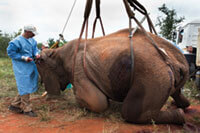
Dean Hendrickson notches the ear of an elephant that has been vasectomized to help keep track of the animal. EPMP monitors of all its patients long after the operation ends. “Nobody’s ever done surgery on these animals out in the bush,” says Zuba. “So we have to make sure we’re doing the responsible thing.”
EPMP has been going to the middle of nowhere in Africa nearly every year since 2004, and performing vasectomies since 2005. It’s operated on some fifty elephants, successfully sterilizing all but five. However, the team would not call any of the surgeries a failure, either, in that at the end of every procedure, the patient got up and rejoined its herd. Over seven years, the group has become increasingly efficient, cutting down the time an operation takes from three hours to close to forty-five minutes. On the last trip to South Africa, they managed to snip sixteen bulls in three days.
The procedure goes, basically, like this. When the EPMP team — which includes not only Zuba, Stetter, and Hendrickson, but also veterinary nurses, wildlife experts, local veterinarians, pilots, drivers, and park rangers, adding up to a group of between twelve and thirty people — assembles, it consults with local wildlife biologists to determine which bulls are likely to be the dominant, breeding males. These are the largest of the bulls, typically, but they’re also the only ones that matter. In a typical herd, only three or four males will service all the females, chasing off any other males.
One crew boards a helicopter to target and corner the bull they wish to vasectomize. They shoot him with a dart laced with etorphine, a narcotic that’s between three thousand and eight thousand times as potent as morphine. As the bull falls under the influence of the drug, the chopper crew herds it into a clearing, keeping radio contact with a second crew that follows in a flatbed truck equipped with a crane that’s strong enough to lift twenty-two football players and three Buicks. When the elephant is down, the truck crew hauls it to another clearing, where a third crew, the surgical team, has set up its instruments.
“We put shackles on his wrists and feet and pick him up by his feet and lay him down on the back of the crane truck,” says Zuba. “Then, when we get [to where the surgical team has set up], we reverse the process. We put a sling under each arm pit and leg pit and lift him into a modified standing position.”
From here, Zuba and Hendrickson take over. Zuba oversees the insertion of IV lines into the elephant’s ear, where its veins are close to the skin’s surface, so that he can monitor blood-oxygen levels and administer more etorphine if the animal seems to be coming around — too much, he notes, and the animal will stop breathing; too little, and he would leave the surgical team at the mercy of several tons of angry patient. Zuba also inserts a six-foot endotracheal tube down the elephant’s throat and begins ventilation. It’s dicey work.
“If you’ve ever been part of a procedure where an animal dies under anesthesia, it’s very terrible,” Zuba says. “It sticks with you.”
Meanwhile, Hendrickson makes an incision in the elephant’s side, about eight to ten inches long. “It sounds large,” says Zuba, “but for an elephant, it isn’t. It’s basically like putting a one-and-a-half centimeter incision in a person’s side.”
Using an air pump called an insufflator, Hendrickson inflates the animal’s abdominal cavity, so that he can move his surgical instruments inside and see where he’s going. He inserts the laparoscope, with its camera and light, as well as scissors and grabbing tools and blunt-edged probes, to move the elephant’s internal organs out of his way.
From there it becomes a treasure hunt: find the testes, then snip the vas deferens, the plumbing through which semen passes to the outside world. In most animals, the vas deferens is a single tube, but in an elephant, it’s a complex of twenty. “We basically look for the kidney,” says Zuba. “Find that, and the testes, and then the vas deferens, and cut out an eight- to ten-centimeter section so that, obviously, the piping is shut down.”
After that, the team takes a series of samples from the patient: DNA, so that they can test it against any baby elephants that may show up in the bull’s herd in the future (just to be certain that they haven’t made any mistakes), and blood, to note nutrient levels.
“We routinely take vitamin samples,” Stetter says. “It’s less about whether the animals in Africa are doing well, but more about animals back in the States. We’ve got hundreds of elephants, and we want to make sure that, nutritionally, we’re giving them the right components. So we measure serum levels of vitamin A or vitamin E, and now we have reference levels [for] what normals are in the wild.”
Also, after each bull is knocked out and before the vasectomy begins, the team takes one more sample. Using an electric probe, the team forces one last ejaculation from the bull, and collects and freezes its semen.
“We’re hoping to create a frozen zoo back in Africa,” Zuba says. “And if we could transport that sperm over to the United States and artificially inseminate a female over here, we could introduce new genetics [into family lines in America] that we couldn’t otherwise get. That’s what Darwin preaches, right? These are the strongest, biggest, most dominant males. We should be keeping those animals.”
Once the operation is finished, they attach a radio collar so that local biologists can track the elephant and monitor his health and behavior.
“If we did all that right,” Zuba says, “the big guy’s back to normal, but shooting blanks.”
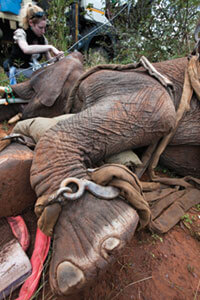
Deena Brenner of EPMP checks anesthesia. After the operation, the team gives the elephant a drug to reverse the etorphine, and then, Zuba says, “everybody backs off.”
Controversy
One other superlative about L. africana: it has a gestation period of twenty-two months — the longest of any land animal. This makes the results of EPMP’s work difficult to measure. Hendrickson estimates that it will take five years to begin to see whether they’ve made any significant impact.
“We’re starting to get to those points now,” he says. “So far, things look promising. We haven’t been able to really pull data, but we’re seeing a reduction in calving, so that’s good. The behavior of the animals seems really good. Now we just have to see what the [population] growth rate becomes.”
The plan has its detractors. By vasectomizing the dominant bulls, are they sabotaging a herd’s genetics? By drastically cutting down on the number of babies, will they radically alter a herd’s social dynamics?
“You seldom see female elephants by themselves,” Zuba says. “If things are normal in their lives, they always have a calf at their feet.”
These concerns make EPMP’s work controversial. Then again, the team knows, that’s the consequence of working with elephants. No matter what you want to do — vasectomize the males, inject PZP in the females, cull them, move them around, or even just leave them alone — if you say you want to do anything, you’ll find someone who disagrees.
“It really caught me off guard, because [vasectomy] seems like such a practical thing to do, offering another [alternative] to either immuno-contraception or to culling,” says Hendrickson. “The problem is that people get really emotionally responsive when you start talking about changing anything with elephants. There’s a whole group of people out there that would have you do nothing — the elephants will respond as the elephants respond. If they starve to death, that’s okay. … But most of these people, they’ve never been to Africa. They have no idea what it looks like, the deforestation that’s occurring.”
Zuba, too, feels the heat of controversy around his work, but he doesn’t see many other paths to take.
“I’ll be the first to say that if somebody wants to put us out of business, that’s great,” he says. “Because it’s expensive, it’s laborious. But it’s really the only option we have right now.”
John Allen, senior editor for On Wisconsin, knows that vasectomizing elephants takes pretty big … ambitions.
Published in the Winter 2012 issue
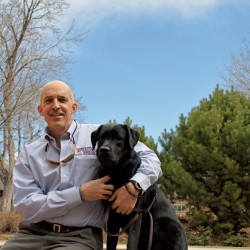
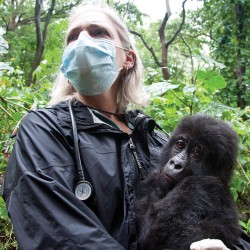

Comments
Don Waller December 1, 2012
Great story – long, but in-depth and compelling. Nicely illustrates a central dilemma in wildlife management. But why no pictures of the vegetation – only elephants undergoing procedures?
Jill Mortimer December 8, 2012
I think this is a fantastic solution (hopefully solution) to the elephant “problem”. Killing of elephants in any way is wrong and this must be very traumatic for the individuals concerned, but as the article says, they are getting better and quicker at it all the time.
I say GOOD LUCK AND KEEP UP THE GREAT WORK – ALL OVER AFRICA, ESPECIALLY IN SOUTH AFRICA WHERE THEY WANT TO START CULLING AGAIN.
Nicky Weitendorf December 12, 2012
I think this is fantastic and very interesting. Better than the culling and leaving young elephants without their mothers.
jane golas March 6, 2013
err..overpopulation?
Most news these days if of serious poaching epidemic in East Africa of elephants because of the huge demand for ivory in China and India.
Has that news not reached Wisconsin?
Their numbers are now at at all time low, the largest land animal, may not be ‘in the wild’ in the near future
‘the Independent” 3-6-2013 article
http://www.independent.co.uk/news/world/africa/an-end-to-elephants-in-africa-species-at-crisis-point-as-illegal-ivory-trade-grows-rapidly-8523165.html
Piet Labuschagne April 3, 2013
This is very interesting and well worth reading. I would have prefered more graphics during the procedure, especially ventilating the patient. We recently ventilated a elephant at Johannesburg Zoo using a ventilator designed specifically for large animals such as elephants. I would like to make contact with the supplier of this item. The only information on it; In Case Of Anaesthesia – San Deago
Disay Hermosura April 20, 2013
Why do we have to interfere with those animals? How can we say that there is an overpopulation of animals when their numbers are declining? Vasectomies create complications in humans, will you be able to understand and know if those vasectomies will be creating complications on those elephants? Will you be able to comprehend it if in the event that the animal would feel anything out of the ordinary after the procedure? Why can’t you just leave those creatures alone? You yourselves don’t know if what you are doing now will have an effect in the long run, yet you are willing to experiment on something uncertain of which the consequences have not yet been established? Got really nothing to do eh?